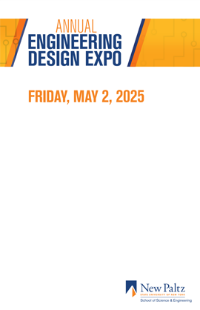Team 1
G.A.P. - Guidance and Pathfinding Drone
Students: William Huang (EE), Glenda Rodrigues Santos Giordani (ME), Jordan Calhoun (CE), Timothy Roach (EE)
Advisor: Dr. Rachmadian Wulandana, Co-advisor: Dr. Wafi Danesh
New students entering college for the first time have a hard time getting around campus. Many of these students try to use campus maps that are hard to find and difficult to read or understand. Specifically, the campus maps are displayed in odd spots that students generally would not pass on their way between classes, additionally the online campus maps are difficult to read being a blurry pdf file in many cases. For this reason, new students often end up late to class and miss vital information during the first few weeks of school. To combat the hard to navigate campus maps and unlabeled buildings the GAP Drone was designed.
Team 2
Thermally Improved Battery Pack
Students: Fetah Medunjanin (ME), Dean Schepisi (EE), James Pousson (ME), Tenmetey Tetteh-Nartey (ME), Anthony Ramirez (ME)
Advisor: Dr. Ping-Chuan Wang
Stakeholder: Kai Di Feng - IKM Technology-143x42.png)
As world infrastructure and transportation evolves and green energy sources become more widespread, the need for reliable and efficient energy storage systems becomes greater. The goal of our project is to explore the effectiveness of cell array battery systems that are cooled internally. The most common form of large-scale battery is found in electric vehicles, where layers of battery components are folded on themselves to allow for quick charge and recharge rates with high energy capacity. This design presents two main issues, the first being that large amounts of heat can be generated near the center of the battery which can increase the rate of degradation for the battery’s energy capacity. The second is that if the casing of the battery is compromised anywhere, the entire battery can fail. Both issues can be addressed when working with arrays of smaller batteries combined to match the performance of a larger battery.
Team 3
Adjustable Height Bed Lift
Students: Ryan Cairns (ME), Nate Cosentino (ME), Peter Hade (ME), Antonio Gonzalez (ME)
Advisor: Dr. Ping-Chuan Wang, Co-advisor: Graham Werner
Stakeholder: Accessadoor/Dana Jones
-125x33.png)
This project introduces an innovative adjustable height bed lift mechanism designed to enhance the comfort and independence of disabled individuals. Our objective was to create a practical, concealed lift solution that departs from the traditional, often dehumanizing appearance of hospital beds, while also remaining cost-effective in comparison. The system is engineered to elevate users by up to 23 inches, thereby facilitating easier transitions into and out of bed either by the help of an aid or by additional transfer mechanisms.
Team 4
Development and Testing of New Sensors to Detect Ice Accumulation on Aircraft Wings
Students: John Urban Quezada (EE), Kevin Lopez (CE), Simon Maranga (EE), Derreck Suhul-Torres (ME)
Advisor: Graham Werner
Stakeholder: PYTHEAS Technology - Simon Clement (CTO)
Aircrafts experience very harsh conditions when in operation. The freezing temperatures along with water vapor in the air can cause ice to accumulate over time. This accumulation can harm the plane’s ability to operate correctly, which is dangerous for passengers and pilots. While planes do have deicing techniques used to help with this, there isn’t any consistent way to detect ice before it becomes an issue. This project seeks to amend this problem by identifying ice accumulation in real time which will help pilots immensely and keep passengers safe.
Team 5
Development of Off-Grid Lighting Product
Students: Shelly Yousoufov (EE)
Advisor: Dr. Kevin Shanley, Co-advisor: Dr. Damodaran Radhakrishnan
Stakeholder: Selux
This project presents the design and development of an off-grid solar-powered street lighting system aimed at delivering a reliable and sustainable lighting solution for areas with limited access to the electrical grid. The system integrates photovoltaic (PV) panels for energy harvesting, a lithium iron phosphate (LiFePO₄) battery system for energy storage, and a motion-activated 24V LED luminaire to optimize energy efficiency. The project evolved from initial NiMH battery storage to LiFePO₄ to enhance system compatibility with the charge controller and improve storage reliability.
Team 6
Advanced Solar Tracking
Students: Marco Hermida (ME), Markus Meyer-Pflug (EE), Kyle Leon (EE), Aboud Abbas (ME)
Advisor: Dr. Mohammad Zunoubi
This research project explores a cost-effective, hybrid solar tracking system that combines both active and passive mechanisms to enhance photovoltaic (PV) efficiency. Traditional dual-axis tracking systems, while effective in maximizing solar energy capture, are often cost-prohibitive, limiting their widespread adoption—particularly in areas distant from the equator where solar angles vary more dramatically. To address this, our interdisciplinary team of electrical and mechanical engineering students designed a low-cost alternative that retains the efficiency benefits of dual axis tracking while reducing complexity and power consumption.
Team 7
LUROX 26 Bi-Pedal Droid
Students: Venn Engstrom Heg (ME), Juan Franco Guzman (ME), Andrew Keefe (EE), Brianna DiBianco (ME), Brian Ordonez (CE), Taheemuddin Ahmed (EE)
Advisor: Dr. Julio Gonzalez, Co-Advisor: Dr. Mahdi Farahikia
Project LUROX 26 focused on the design and construction of an affordable, modular bipedal robot intended for educational and experimental use. Starting in August, the project encompassed the full development cycle—from 3D modeling and high-speed PLA printing of structural components to custom electronics and embedded programming. Key design features include a distributed control system using ESP32-S3 microcontrollers on custom PCBs for each limb, as well as a centralized power distribution board supporting lithium-ion battery operation.
Team 8
Magnetic Charging Table
Students: Lucas Douglas (EE), Noah Silliman (ME), Julia Bossonis (EE), Steven Kumas (CE)
Advisor: Dr. Mohammad Zunoubi
This project presents the development of a wireless charging table that autonomously aligns a power transmission coil with the position of a Qi-enabled mobile device. A key challenge in magnetic charging is ensuring precise coil alignment, as even slight misalignments can significantly reduce power transfer efficiency and increase heat generation. The system integrates a dual-axis XY tracking platform utilizing belt-driven linear rails actuated by 42HBRC0001Y-24B stepper motors and TB6600 stepper drivers. KY-008 650 nm laser modules and photodiode receivers mounted on the upper carriage scan the table surface in both X and Y directions. The software logs each scanning cycle and records the coordinates where beam interruptions occur.
Team 9
Voice-Controlled Boom-Box
Students: Oliver Trzcinski (ME), Sabina Sobhy (EE), Uriel Cruz (CE), Brian Lopez (EE), Corey Barber (EE), David Lin (CE)
Advisor: Dr. Vincent Liao, Co-advisor: Graham Werner
Stakeholder: Mike Maclsaac and John Grube
The issue of modern smart sound systems is that they rely on using their own services to benefit from the consumers of using their data. With the lack of boomboxes that have the sound quality of expensive brands and have features such as voice commands. Therefore, we wanted to help design a quality boom box using parts that can be bought relatively easily, make it portable and have it display information while using our stakeholder's guidance on how to implement the design.
Team 10
Wrist Mounted Grappling Hook
Students: Marcus A. Pena (ME), Montana Prais (ME), Matthew Selvaggio (ME), Jean Merejildo Diaz (ME), Omri Downes (ME), Jacobus Hockx (EE)
Advisor: Dr. Mahdi Farahikia
Our project is a wrist mounted grappling hook for professional and recreational use, such as for wall traversal and item retrieval. We designed a fluid pneumatic propulsion system using carbon dioxide and incorporated a reel-back system to retract the cable and hook after use. The motivation behind our project was to attempt to tackle a unique and fun project. It allowed us to connect theory with real world applications while also pushing our creative and engineering skills by creating a device that's thrilling, unique and awesome to experience.
Team 11
Wind Power On The Go
Students: Justin Wagner (ME), Alban Kalaj (ME), Alenton Findley (ME), Puneet Mangat (EE)
Advisor: Dr. Kevin Shanley
Kamituga is a small mining town located in the Democratic Republic of Congo. While this town is essential to the country for obtaining valuable resources, its electricity needs remain limited, where they rely on gas generators as the state’s electrical grid is underdeveloped. There are many areas around the world that may not have access to clean energy, and many more that have no access at all, even to power a simple lightbulb. What our project aims to do is to provide a small source of clean, reusable energy that can be used to power lights or small appliances and act as a secondary power source.
Team 12
LawnPilot: Robotic Lawnmower
Students: David Candia-Domingo (ME), Kimani Frankson (ME), Jonathan Mitchell (CE), Pavan Kang (ME), Faith Apostilides (ME)
Advisor: Dr. Heather Lai, Co-advisor: Kerry Ford
The LawnPilot showcases a remote-controlled, electrically powered robotic lawnmower designed to offer homeowners a safe, quiet, quality, green and user-friendly solution for lawn care. By integrating advanced electronics with robust mechanical engineering, the robotic system provides a strong alternative to traditional mowers.
Team 13
Autonomous Food Delivery Car
Students: Ryan Zhang (CE), Ryan Schubert (CE), Mark Camitan(EE), Benjamin Weisfeld (EE), Alexander Krupinski (ME), Owen McGarrity (ME)
Advisor: Dr. Wafi Danesh, Co-advisor: Kerry Ford
This project presents the development of a GPS-enabled vehicle designed for autonomous food delivery, and aimed at enhancing convenience and addressing time management issues for the campus community. The vehicle integrates GPS for navigation, allowing the vehicle to autonomously follow pre-programmed routes and deliver food without manual intervention. The system includes key features such as obstacle detection and avoidance ensuring safe navigation by detecting and maneuvering around obstacles on a path. Additionally, users can schedule food pickups and deliveries through a mobile app, streamlining the process and reducing the need for manual involvement.
Team 14
Convective Cooling Experiments for Thermal Fluid Lab
Students: Sophia Banks (ME), Adam Bass (EE), Kyra Burnside (CE), Shahed Herzallah (ME), Roberto Sanchez (ME)
Advisor: Dr. Rachmadian Wulandana, Co-advisor: Dr. Amr Abdo
This project aims to improve the inadequate heat transfer lab setup at SUNY New Paltz by introducing two experimental modules to help students better understand heat dissipation principles. The primary focus is on modeling the heat transfer behavior of heating elements placed inside insulated Delrin blocks, equipped with temperature sensors, and covered by a copper plate. The setup is used to analyze temperature distribution across a copper plate, study convective cooling effects, and assess the efficiency of heat dissipation from a central heat source to the environment.













